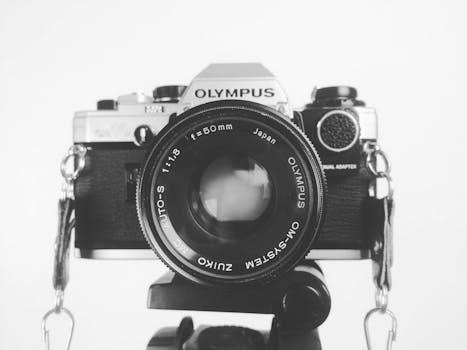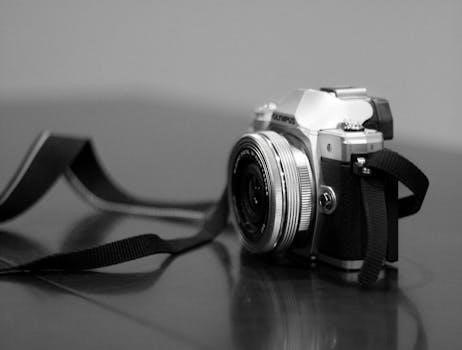
Olympus OM-1 Instruction Manual⁚ A Comprehensive Guide
Welcome to the comprehensive guide for the Olympus OM-1, a masterpiece of engineering. This manual provides essential instructions, covering everything from basic operation to advanced features. Whether you are a beginner or experienced, this guide will help you.
The Olympus OM-1 stands as a testament to innovative design and exceptional build quality, marking Olympus’s entry into the professional SLR market. Released initially in 1973, this camera quickly gained recognition for its compact size and robust performance. This guide delves into the intricacies of the OM-1, offering both novice and seasoned photographers a comprehensive understanding of its features and operation.
The OM-1 is more than just a camera; it is a tool that connects the photographer to the art of image creation. Its mechanical design ensures reliability and longevity, allowing for complete manual control over the photographic process. This manual aims to be your trusted companion, guiding you through every aspect, from loading film to mastering advanced techniques, ensuring you unlock the full potential of this classic camera.
Key Features and Specifications
The Olympus OM-1 boasts a range of impressive features that set it apart during its time and continue to make it a cherished classic today. Key among these is its fully mechanical operation, providing dependable performance without relying on batteries for shutter function. This ensures that photographers can continue shooting even when the battery for the light meter is depleted.
The camera features a bright viewfinder with comprehensive exposure information. Specifications include a focal plane shutter with speeds ranging from 1 second to 1/1000th of a second, plus Bulb mode for long exposures. The OM-1 also offers a manual film rewind, a mechanical frame counter, and compatibility with a wide range of Zuiko lenses, known for their sharpness and clarity. Furthermore, the OM-1’s compact and lightweight design makes it an ideal companion for photographers on the go, without compromising on build quality or image quality. It truly represents a blend of form and function.

Getting Started with Your OM-1
Ready to begin your photographic journey with the Olympus OM-1? This section guides you through initial steps. We’ll cover unpacking, basic setup, and preparing your camera for its first use. Let’s get started with this amazing camera!
Unpacking and Initial Setup
Congratulations on acquiring the Olympus OM-1! Let’s begin by carefully unpacking your camera. Ensure that you have all the components⁚ the OM-1 body, the lens (if included), the camera strap, and any accompanying documentation like warranty information. Inspect each item for any signs of damage incurred during shipping.
Once you’ve inventoried the contents, take some time to familiarize yourself with the camera’s external features. Locate the shutter button, film advance lever, rewind knob, and lens release button. Understanding the placement of these controls is crucial for smooth operation.
Next, attach the camera strap. This will prevent accidental drops and keep your OM-1 secure while you’re shooting. Thread the strap through the designated eyelets on either side of the camera body, ensuring a snug and secure fit. A well-attached strap is essential for comfortable and safe handling.
Finally, give your OM-1 a thorough visual inspection. Check the lens mount, film compartment, and battery chamber (if applicable for accessories). Make sure everything is clean and free from obstructions. This initial check will help ensure optimal performance and longevity for your classic OM-1.
Battery Installation and Charging (If Applicable)
The Olympus OM-1, being a classic film camera, operates primarily mechanically and does not require a battery for its core functions like shutter operation or film advance. However, certain accessories, such as the light meter, do require a power source. If you intend to use the built-in light meter or an external one designed for the OM-1, you will need to install a battery.
The original OM-1 used a mercury battery, which are no longer available due to environmental concerns. A suitable replacement is a readily available alkaline or silver oxide battery of the correct voltage (typically 1.35V or 1;5V). Before inserting the battery, consult your light meter’s manual for the specific type it requires.
To install the battery, locate the battery compartment, usually found on the bottom of the camera or within the light meter accessory itself. Use a small screwdriver or coin to open the compartment. Insert the battery with the correct polarity (+/-), as indicated inside the compartment. Ensure the battery sits snugly and the compartment is securely closed.
If using an external light meter, refer to its individual instructions for battery installation and operation. Remember to remove the battery when the meter is not in use for extended periods to prevent corrosion and damage. Proper battery care will ensure accurate metering and prolong the life of your OM-1 accessories.
Loading Film and Setting the ISO
Loading film into your Olympus OM-1 is a fundamental step to capturing those timeless images. Begin by opening the camera back; typically, this is done by pulling up the rewind knob located on the top left of the camera. With the back open, insert a fresh roll of 35mm film into the film chamber on the left side, ensuring the film canister sits securely.
Next, pull the film leader across the camera body and insert the tip into one of the slots on the take-up spool located on the right. Advance the film using the film advance lever, usually located on the top right, making sure the film catches properly and the sprocket holes align with the teeth on the film transport mechanism.
Close the camera back. Advance the film two or three times, continuing until the frame counter displays “1”. This ensures any exposed film is moved past, and you’re ready to start shooting on a fresh frame. Now, set the ISO (film speed) on the camera. Locate the ISO dial, often found around the shutter speed dial. Rotate the dial to match the ISO of the film you loaded. This setting tells the camera’s light meter how sensitive the film is to light.

Operating the OM-1
Mastering the Olympus OM-1 involves understanding its controls. Learn about metering, exposure, and focusing techniques. This section guides you through the essential operations, allowing you to confidently capture stunning photographs with your OM-1.
Understanding the Controls and Dials
The Olympus OM-1 boasts a classic design with intuitive controls. Familiarizing yourself with these elements is crucial for effective operation. The shutter speed dial, often located on the front, allows you to control exposure duration. Understanding aperture settings is paramount for depth of field.
The lens typically features an aperture ring. This allows you to manually adjust the lens opening. The focusing ring enables precise control over image sharpness. The film advance lever advances the film to the next frame. This prepares the camera for your subsequent shot.
The rewind knob allows you to rewind the film back into the canister once you’ve completed your roll. The ISO dial lets you match the camera’s light sensitivity to your film’s rating. Mastering these controls unlocks the full potential of the OM-1, empowering you to create beautiful images.
Each control serves a vital role in the photographic process, offering creative flexibility. Experiment and observe how each adjustment influences your final image. This hands-on approach will deepen your understanding of the camera. It will also improve your photographic skills.
Metering Modes and Exposure Settings
The Olympus OM-1 relies on its internal light meter to determine proper exposure. Understanding how this system works is critical for achieving well-exposed photographs. The OM-1 primarily uses center-weighted metering. This emphasizes the light in the center of the frame; This is for calculating exposure.
To use the meter, set your desired aperture or shutter speed. Then, observe the needle in the viewfinder. Adjust the remaining setting until the needle centers. This indicates the recommended exposure. For tricky lighting situations, exposure compensation can be applied.
Overexpose or underexpose your image by adjusting the aperture or shutter speed accordingly. Remember the Sunny 16 rule. This provides a baseline exposure in bright sunlight. Experiment with different exposure settings to achieve your desired aesthetic. Careful attention to metering ensures consistent results.
Mastering exposure settings enables you to capture images as you envision them. By understanding the interplay between aperture, shutter speed, and ISO, you gain creative control. Use the meter as a guide, but trust your instincts and artistic vision for expressive images.
Focusing Techniques and Depth of Field
The Olympus OM-1 employs manual focusing. This is where precise control over sharpness is essential. The focusing screen features a microprism collar. This aids in achieving critical focus. Rotate the lens focusing ring until the image appears sharpest in the viewfinder. Pay close attention to fine details to ensure accuracy;
Depth of field refers to the area in front of and behind the focus point that appears acceptably sharp. Aperture plays a key role in determining depth of field. Smaller apertures (higher f-numbers) yield greater depth of field. This brings more of the scene into focus.
Larger apertures (lower f-numbers) result in shallow depth of field; This isolates the subject. It blurs the background. Experiment with different apertures to achieve the desired effect. Consider the distance to your subject and background when assessing depth of field.
For landscapes, choose a smaller aperture for maximum sharpness. For portraits, a wider aperture can create beautiful background blur. Practice these focusing techniques to master the art of selective focus. Use depth of field to enhance your storytelling.

Advanced Features and Troubleshooting
Explore the advanced capabilities of your Olympus OM-1, including self-timer functions. Learn troubleshooting steps for common issues. Master manual rewind techniques and frame counter operations. This section enhances your overall experience with the camera.
Using the Self-Timer
The Olympus OM-1 features a self-timer, allowing you to include yourself in your photographs. To utilize the self-timer, first, ensure your camera is properly mounted or stabilized. Locate the self-timer lever, typically found on the front of the camera body near the lens mount.
Next, wind the self-timer lever to set the desired delay, usually around 10 seconds. After winding, fully depress the shutter button. The self-timer mechanism will engage, and you will hear a ticking sound as the timer counts down. Position yourself within the frame before the shutter releases.
This feature proves invaluable for group photos or capturing self-portraits. Remember to check your composition and focus before activating the self-timer to ensure the final image meets your expectations. The self-timer adds versatility, giving you time to join the scene.
Experiment with different poses to create unique photographs with you in them. Don’t forget to consider lighting conditions to ensure the best possible outcome. With practice, you’ll master the self-timer, expanding the creative possibilities of your OM-1.
Manual Rewind and Frame Counter
The Olympus OM-1 utilizes a manual film rewind system. Once you’ve finished shooting a roll of film, you’ll need to rewind it back into the canister before opening the camera back. First, locate the film rewind knob, usually found on the top left of the camera.
Before rewinding, press the film rewind release button, typically located on the bottom of the camera. This disengages the film advance mechanism. Then, gently lift and turn the rewind knob in the direction indicated by the arrow, usually clockwise. You’ll feel resistance as the film winds back.
Pay attention to the frame counter, which indicates how many exposures you’ve taken. As you rewind, you’ll feel a sudden release of tension, indicating the film has fully detached from the take-up spool. Continue rewinding a little further to ensure the film leader is completely inside the canister.
The frame counter will give you an idea of how far you are in the rewind process. Once you’re sure the film is rewound, you can safely open the camera back and remove the film canister for developing. Always rewind carefully to prevent damage to the film.
Troubleshooting Common Issues
Even with its robust design, the Olympus OM-1 can sometimes encounter issues. One common problem is a jammed shutter. Ensure the camera is not set to ‘B’ (Bulb) mode accidentally, as this keeps the shutter open. If the shutter is still stuck, gently try cycling the film advance lever.
Another issue is underexposed or overexposed images. Verify that the battery is fresh, as a weak battery can affect the light meter’s accuracy. Also, double-check your ISO setting to match the film you’re using. If the meter seems erratic, clean the battery contacts with a soft cloth.
If your images have light leaks, inspect the light seals around the camera back and lens mount. Over time, these seals can degrade and crumble, allowing light to enter. Replacement light seal kits are available online.
Film not advancing properly? Make sure the film is loaded correctly and the take-up spool is engaged. If problems persist, a CLA (Clean, Lube, and Adjust) service by a qualified technician may be necessary to address internal mechanical issues within your OM-1.